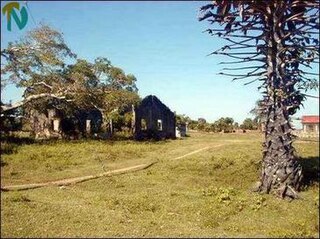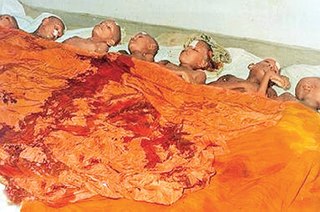
The Sri Lankan Civil War was a civil war fought in Sri Lanka from 1983 to 2009. Beginning on 23 July 1983, it was an intermittent insurgency against the government by the Velupillai Prabhakaran-led Liberation Tigers of Tamil Eelam. The LTTE fought to create an independent Tamil state called Tamil Eelam in the north-east of the island, due to the continuous discrimination and violent persecution against Sri Lankan Tamils by the Sinhalese-dominated Sri Lanka government.

Kumarapuram massacre also known as 1996 Trincomalee massacre or 1996 Killiveddy massacre refers to the murder of 26 Sri Lankan Tamil civilians by the Sri Lankan Army soldiers on February 11, 1996. The victims included 13 women and 9 children below the age of 12. Further 28 civilians were severely injured as well. The event took place in a village called Kumarapuram, located in the eastern district of Trincomalee. It was a notable mass murder of civilians since the resumption of armed conflict between rebel forces and Sri Lankan armed forces since April 1995, as part of the Sri Lankan civil war. The then-government arrested a number of soldiers and home guards who allegedly carried out the massacre. A court case was started on 2004. On 27 July 2016 the court acquitted six former army Corporals who were accused over the massacre, after they were found not guilty.

The Allaipiddy massacre or Allaipiddy murders refers to the May 13, 2006 killing of 13 minority Tamil civilians in separate incidents in three villages in the islet of Kayts in northern Sri Lanka.

The Chencholai bombing took place on August 14, 2006 when the Sri Lankan Air Force bombed what it said was a rebel Liberation Tigers of Tamil Eelam (LTTE) training camp, killing 61 girls aged 16 to 18. The LTTE, UNICEF, the Sri Lanka Monitoring Mission and UTHR all said those in the compound were not LTTE cadres.
The Kent and Dollar Farm massacres were the first massacres of Sinhalese civilians carried out by the LTTE during the Sri Lankan Civil War. The massacres took place on 30 November 1984, in two tiny farming villages in the Mullaitivu district in north-eastern Sri Lanka. The Sri Lankan government labeled this as an attack on civilians by the LTTE.
The Kokkilai massacre was carried out by the Liberation Tigers of Tamil Eelam.
The Anuradhapura massacre occurred in Sri Lanka in 1985 and was carried out by the Liberation Tigers of Tamil Eelam. This was the largest massacre of Sinhalese civilians by the LTTE to date; it was also the first major operation carried out by the LTTE outside a Tamil majority area. Initially, EROS claimed responsibility for the massacre, but it later retracted the statement, and joined the PLOTE in denouncing the incident. The groups later accused the LTTE for the attack. Since then, no Tamil militant group has admitted to committing the massacre. However, state intelligence discovered that the operation was ordered by the LTTE's leader Velupillai Prabhakaran. He assigned the massacre to the LTTE Mannar commander Victor and it was executed by Victor's subordinate Anthony Kaththiar. The LTTE claimed the attack was in revenge of the 1985 Valvettiturai massacre, where the Sri Lanka Army killed 70 Tamil civilians in Prabhakaran's hometown.
The Palliyagodella massacre was carried out by the Liberation Tigers of Tamil Eelam (LTTE) against the mostly Muslim population of the Palliyagodella village located on border region of the northern part of Sri Lanka that were controlled by the Tigers at the time. This was the largest massacre of Muslim civilians by the LTTE to date. Village eyewitnesses claim that some 285 men, women and children, around a third of the population, were killed by a 1,000 strong force of the Tamil Tigers; however, the Sri Lankan government states that the LTTE massacred 166 to 171. All but 40 of the victims of the Palliyathidal massacre were Muslim; the rest were Sinhalese.
The Gonagala Massacre was a massacre that occurred on 18 September 1999, in the small village of Gonagala, located in the Ampara District of Sri Lanka. According to reports, over 50 men, women and children were hacked to death in the middle of the night. The massacre is attributed to the LTTE, which is banned as a terrorist organisation by a number of countries including the United States, the United Kingdom and the European Union.
The Kallarawa massacre was carried out by the LTTE, an organisation which has been banned in 33 countries including the US, Australia, EU, India and Canada due to its terrorist activities.
Eelam War I is the name given to the initial phase of the armed conflict between the government of Sri Lanka and the LTTE.

Eelam War II is the name given to the second phase of armed conflict between Sri Lankan military and the separatist Liberation Tigers of Tamil Eelam. The war started after the failure of peace talks between the Premadasa government and the LTTE. This phase of the war was initiated by the LTTE who massacred almost 600 Sinhalese and Muslim police personnel after they were ordered by the Premadasa government to surrender to the LTTE. The truce was broken on June 10, 1990 when the LTTE in October expelled all the 28,000 Muslims residing in Jaffna.
Eelam War III is the name given to the third phase of armed conflict between the Sri Lankan military and the separatist Liberation Tigers of Tamil Eelam (LTTE).

The Aranthalawa massacre was the massacre of 33 Buddhist monks, most of them young novice monks, and four civilians by cadres of the Liberation Tigers of Tamil Eelam organization on June 2, 1987, close to the village of Aranthalawa, in the Ampara District of Eastern Sri Lanka. The massacre is among the most notorious and devastating atrocities committed by the LTTE during the history of the Sri Lankan Civil War, and continues to be commemorated 35 years on.
The Mahawilachchiya massacre is an incident, where a group of four ethnic Sinhalese rice farmers, including a woman found dead with gunshot wounds on November 26, 2007, in Sri Lanka. Incident occurred at the village of Mahawilachchiya in the Anuradhapura District, 222 km from the island's commercial capital Colombo and this was attributed to the Liberation Tigers of Tamil Eelam also known as Tamil Tigers which is proscribed as a terrorist organisation by 32 countries.
The Aluth Oya massacre was the massacre of 127 Sinhalese civilians, including children and women, by the cadres of Liberation Tigers of Tamil Eelam organization on April 17, 1987, near the village of Aluth Oya, on the Habarana Trincomalee road in North Central Province of Sri Lanka. This massacre is considered one of the most notorious and devastating atrocities committed by the LTTE during the history of the Sri Lankan Civil War.
The Veeramunai massacres refers to the mass killing and disappearances of over 250 Tamil civilians by Sri Lankan security forces and Muslim home guards in 1990.






